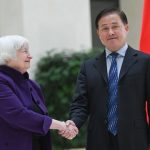 Chicago Board of Trade
Chicago Board of TradeIn the late 1960s, as exchange volume for commodities began to shrink, the Chicago Board of Trade (CBOT) explored opportunities for diversification into the options market. Joseph W. Sullivan, Vice President of Planning for the CBOT, studied the over-the-counter option market and concluded that two key ingredients for success were missing. First, Sullivan believed that existing options had too many variables. To correct this, he proposed standardizing the strike price, expiration, size, and other relevant contract terms. Second, Sullivan recommended the creation of an intermediary to issue contracts and guarantee settlement and performance. This intermediary is now known as the Options Clearing Corporation.
To replace the put-call dealers, who served only as intermediaries, the CBOT created a system in which market makers were required to provide two-sided markets. At the same time, the presence of multiple market makers made for a competitive atmosphere in which buyers and sellers alike could be assured of getting the best possible price.
 Chicago Board Options Exchange (CBOE)
Chicago Board Options Exchange (CBOE)After four years of study and planning, the Chicago Board of Trade established the
Chicago Board Options Exchange (CBOE) and began trading listed call options on 16 stocks on April 26, 1973. The CBOE’s first home was actually a smoker’s lounge at the Chicago Board of Trade. After achieving first-day volume of 911 contracts, the average daily volume skyrocketed to over 20,000 the following year. Along the way, the new exchange achieved several important milestones.
As the number of underlying stocks with listed options doubled to 32, exchange membership doubled from 284 to 567. About the same time, new laws opened the door for banks and insurance companies to include options in their portfolios. For these reasons, option volume continued to grow. By the end of 1974, average daily volume exceeded 200,000 contracts.
The Emergence of Put Trading
After repeated delays by the SEC, put trading finally began in 1977. Determined to monitor the situation closely, the SEC only permitted puts to be traded on five stocks. Despite the rapid acceptance of puts and the rising interest in options, the SEC imposed a moratorium halting the listing of additional options. Nevertheless, annual volume at the CBOE reached 35.4 million in 1979.
After repeated delays by the SEC, put trading finally began in 1977. Determined to monitor the situation closely, the SEC only permitted puts to be traded on five stocks. Despite the rapid acceptance of puts and the rising interest in options, the SEC imposed a moratorium halting the listing of additional options. Nevertheless, annual volume at the CBOE reached 35.4 million in 1979.
Today, more than ever, option volume and open interest continues to climb. In 1999 alone, option volume at the CBOE doubled. By the end of 1999, the number of open contracts reached almost 60 million.




 Other Exchanges Get Into the Game
Other Exchanges Get Into the GameStarting in 1975, a number of other exchanges began trading listed options. This group included the American Stock Exchange (AMEX), the Pacific Stock Exchange (PSE), and what is now known as the Philadelphia Stock Exchange (PHE). The most recent players to enter the game are the International Securities Exchange (ISE), Boston Options Exchange (BOX), and Archipelago, now NYSE Arca. Although the ISE only trades options on a limited number of stocks, the list is literally growing every day. Today, options on all sorts of financial instruments are also traded at the Chicago Mercantile Exchange, the CBOT, and other exchanges.
 Exchange Traded Options
Exchange Traded Optionsexchange-traded options are issued by the Options Clearing Corporation (OCC). By centralizing and standardizing options trading, the OCC has created a more liquid market.
Other Articles That May Interest You …

|
|
November 5th, 2006 by financetwitter
|


|

|

|

|

|

|




























Comments
Add your comment now.
Leave a Reply